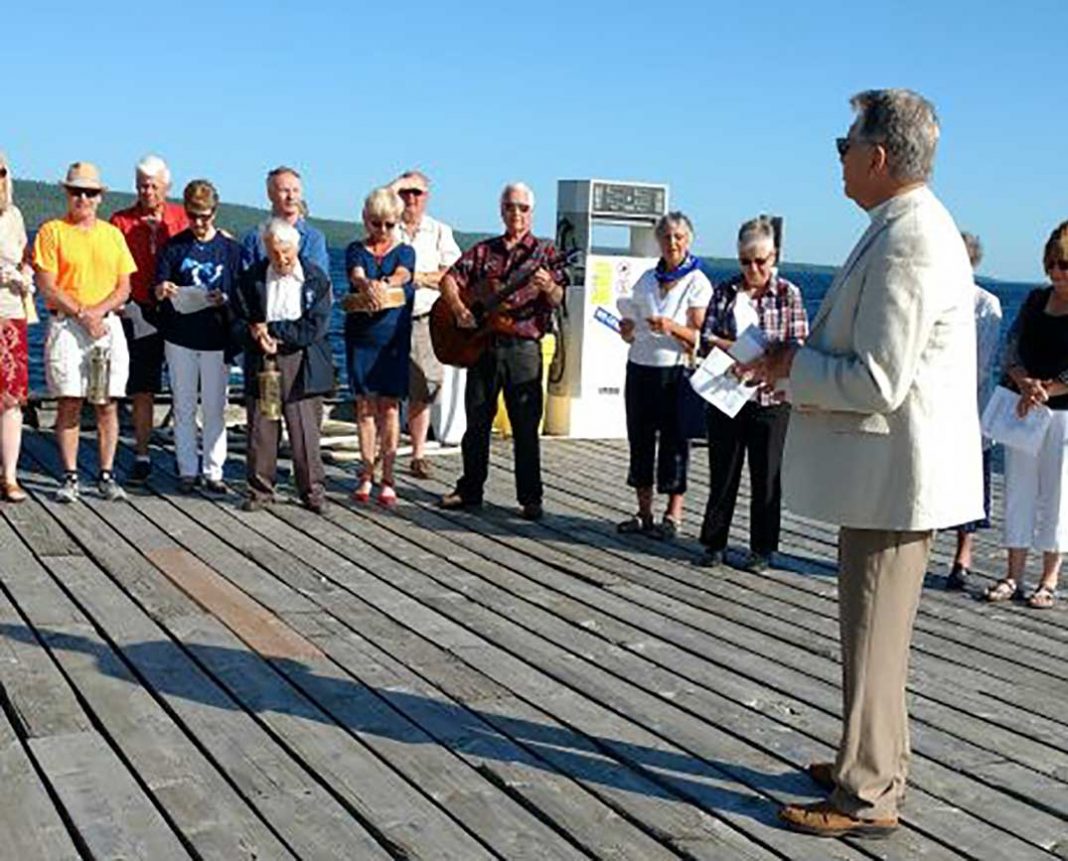KAGAWONG – The history of the Kagawong Lighthouse was featured at the annual Blessing of the Boats and Marine Service, held at St. John the Evangelist Anglican Church as part of the Kagwong Summer Fest celebrations.
The service was given by Reverend George Gaiser as the congregation proceeded to the marina for the blessing of the boats. “Great Creator of the waters and the winds, we ask your blessing on these boats and those who travel in them. Watch over them as they sail over the waves, give them fair winds and safe passage, pleasant journeys and good harbours. May they see your hand upon their voyage, granting them safety to their journey’s end.”
Everyone then took part in the hymn of ‘He’s Got the Whole World’ amended to a marine version led by Doug Alkenbrack on the guitar.
Once everyone had arrived back in the church, Dianne Fraser provided the lighthouse history. “William and Robert Henry, two brothers who co-founded Kagawong, came from King Township near Toronto in the late 1800s. They were interested in obtaining timber rights and building a sawmill by Bridal Veil Falls. The government granted them the land provided they bring in 12 families and also build a grist mill for the developing community.”
“Kagawong was becoming a busy Manitoulin port because before the days of modern vehicles and roads, ships were the principal means of transportation. People, animals, mail, goods and services all travelled by ship,” she said.
“In the 1880s to the late 1940s there were three busy wharfs in this harbour of Mudge Bay: the marina dock, the McKenzie General Merchant and Pulpwood dock and the Graham brothers dock,” said Ms. Fraser. “Lighthouses became a necessity on the Great Lakes to help guide ships so they could navigate safely from port to port. Around 300 lighthouses have been built throughout the five Great Lakes since 1808. About 70 are on the shores of Lake Huron and Georgian Bay. Nine lighthouses were built on Manitoulin Island with six on surrounding islands between 1866 and 1918. These lighthouses were mostly painted white with red roofs and trim.”
Lake ships like the Normac, Norgoma, Manitou, Georgian, Manitoulin, Bon Ami and Argo visited Kagawong bringing in much needed goods and transporting out products like pulp, lumber, fish, livestock and produce, she explained. “Initially, simple pole lights guided ships into Mudge Bay Harbour. John Gray was hired in 1888 to build a 25-foot-tall mast light with a shed at the bottom to store the kerosene that lit the light.”
Ms. Fraser noted that in 1892, a fire swept through Kagawong destroying much of the village and the lighthouse. The following is an excerpt from LighthouseFriends.com explaining what took place: “Tenders were invited for the erection of a small enclosed tower to replace the mast light, but the bids received were so high that the Department of Marine delayed the project until one of its foremen could be sent to Kagawong to build the new lighthouse using days’ labour.
“The Department of Marine’s report for 1894 details the construction of Kagawong’s second lighthouse: Mr. Noble was sent to Kagawong in September last, and erected a lighthouse to replace the temporary light maintained since the mast and shed were destroyed by fire. This tower was completed for the sum of $293.81, thereby, justifying the department’s action in refusing to accept any of the tenders received for the work, the lowest having been $925.”
“The tower is built in the same location as the original mast…it is a square pyramidal wooden building, surmounted by a wooden lantern, and is 27 feet high from its base to the vane on the lantern. The tower is painted white, the lantern red. The light is a fixed white catoptric light, elevated 38 feet above the level of the bay,” continued Ms. Fraser. “It should be visible 11 miles from all points of approach by water. It was first shown from the new tower on the 29th of October, 1894.”
The tower is still in operation today, at its original location, a small hill overlooking the bay. The white wooden structure rises to decorative supports that help hold the square walkway and red square lantern room. The light was changed to a fixed red light in 1950 and then automated in the 1960s.
“After the pulp mill’s closure in 1932, Kagawong still prospered as it was a favourite place for excursion steamers en route to Lake Superior,” said Ms. Fraser. “Today, the boat traffic is mainly pleasure crafts, fishing boats, tour boats and sailboats but the lighthouse still stands to guide mariners into Mudge Bay and this pretty little village of Kagawong.” The lighthouse has also become a tourist attraction and has a sign sharing its history.
Lighthouse keepers through the years has been John Gray, 1888-1890; Henry Sullivan, 1890-1891; William Boyd, 1892-1923; Jacob McPherson, 1923-1926; William McKenzie, 1927-1958; Florence McKenzie, 1958; and Austin Hunt 1960s.
“The Ministry of Fisheries and Oceans is still responsible for the lighthouses of Canada. It updated and painted the still-active Kagawong lighthouse in 2010. Although Canada’s lighthouses are not in as much demand as they once were with the advent of global positioning system and modern technology, they still serve an important purpose and people enjoy visiting and learning about their iconic history,” said Ms. Fraser, who also read a poem written by a former minister Beth Topps for the St. John’s Memorial window which also depicts a very early lighthouse.





